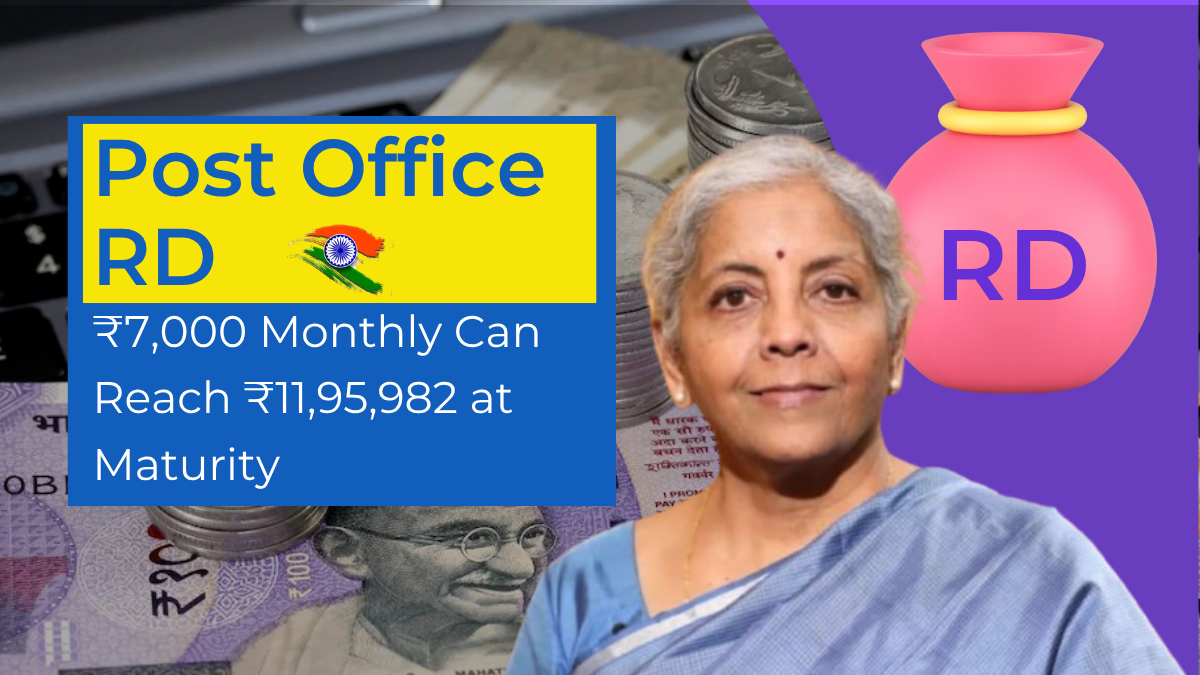The Post Office Recurring Deposit is a disciplined savings plan backed by the Government of India. You deposit a fixed amount every month and earn guaranteed interest that is compounded quarterly. If you set aside ₹7,000 per month for 10 years at a 6.7 percent annual rate with quarterly compounding, your maturity value can be about ₹11,95,982. This makes the RD a strong choice for families and salaried earners who prefer steady growth without market risk.
Table of Contents
Why the Post Office RD Works for Consistent Savers

- Sovereign backing
Operated through India Post, the RD provides safety of principal and assured returns as per notified interest rates. This is ideal for conservative investors who want predictability. - Easy monthly discipline
Depositing a smaller monthly amount is often easier than arranging a large one time investment. The RD makes long horizon goals manageable. - Quarterly compounding advantage
Interest is added every quarter, and future interest is calculated on the increased base. Over long periods this snowball effect adds meaningful growth. - Flexibility for families
You can open single or joint accounts. Parents can open an RD in a minor’s name to build an education or wedding fund over 10 years. - Liquidity via loan
If unexpected expenses arise, a loan against the RD balance may be available. This helps you avoid breaking the deposit while still meeting cash needs.
Quick Summary
Key Point |
Details |
|---|---|
Scheme |
Post Office Recurring Deposit RD |
Monthly Deposit |
₹7,000 |
Tenure |
10 years 120 months |
Interest Rate |
6.7 percent per annum compounded quarterly |
Total Deposited |
₹8,40,000 |
Maturity Value |
About ₹11,95,982 |
Risk Level |
Sovereign backed, principal and interest guaranteed as per scheme rules |
Premature Access |
Loan against RD available as per rules |
Official Site |
The ₹7,000 Per Month Illustration
Inputs used
- Monthly installment ₹7,000
- Tenure 10 years 120 installments
- Interest rate 6.7 percent per annum compounded quarterly
Outputs derived
- Total amount you deposit ₹7,000 x 120 equal to ₹8,40,000
- Approximate maturity value after 10 years about ₹11,95,982
- Total interest earned about ₹3,55,982
What the numbers mean
Regular, on time monthly deposits benefit more than ad hoc saving because each quarter the account receives interest on the accumulated balance. Over 10 years the compounding effect magnifies the difference between simple saving and disciplined RD investing.
Note
RD interest rates are reviewed periodically. The illustration above uses a 6.7 percent rate as stated in the article brief. Your final maturity value depends on the actual rates notified during your deposit period and the exact dates of deposits and compounding.
How the Compounding Works in Practice
- Monthly deposits keep adding to the balance.
- Quarterly compounding credits interest after every three months based on the scheme’s rules.
- Long duration increases the share of maturity value coming from interest rather than principal.
- On time payments matter because missed or delayed deposits can reduce compounding benefits and may attract a small default fee as per rules.
A simple way to visualise compounding is to compare totals. Without interest, ₹7,000 saved for 120 months is ₹8,40,000. With quarterly compounding at 6.7 percent, the gap between ₹8,40,000 and ₹11,95,982 is the compounding gain you get for staying invested and timely.
Who Should Consider a Post Office RD
- Salaried individuals who can comfortably set aside a fixed amount each month
- Small business owners who want a safe buffer fund for future needs
- Parents building a child centric corpus without market volatility
- Retirees who prefer predictable growth with zero equity exposure
If you are unsure about market linked products or you want a guaranteed maturity figure for a medium to long horizon, the RD fits those needs well.
Opening and Managing the Account
- Eligibility and documents
KYC documents such as PAN, Aadhaar, and a recent photograph are typically required along with address proof. - Where to open
Visit your nearest post office or use the India Post portal if online opening and servicing are enabled for your circle. - Funding method
Set up standing instructions from a savings account so deposits remain punctual. Many branches allow auto debit to avoid missed installments. - Nomination
Always set a nominee to simplify claim procedures. - Loan against RD
After a stipulated lock in period and subject to rules, you may avail a loan against the RD balance. This helps you bridge short term needs without closing the account. - Premature closure
Permitted under conditions laid down by the scheme. Premature closure reduces the compounding benefit and may change the applicable interest rate.
Pros and Considerations
Advantages
- Government backed safety
- Fixed monthly habit that builds a sizable corpus
- Guaranteed compounding based on notified rates
- Useful loan facility to preserve the deposit
Points to note
- Interest rate can change for new deposits as per quarterly notifications
- Missing installments affects returns
- Not meant to beat high inflation over decades like equities, but excels at stability and certainty
Goal Based Ideas Using ₹7,000 Per Month
- Education fund over 10 to 12 years
- Home upgrade reserve for appliances or interiors after a decade
- Down payment accumulator for a car planned several years ahead
- Emergency buffer grown systematically without market swings
Pick a tenure that matches your purpose. For goals beyond 10 years, you can ladder multiple RDs or combine RD with other products based on your risk profile.
Frequently Asked Questions
1. Can I change the monthly deposit after opening the RD
No. The monthly installment is fixed for that account. You can open a second RD if you want to save more later.
2. What happens if I miss an installment
A default fee may apply as per rules and the missed deposit should be cleared quickly. Persistent delays reduce compounding benefits.
3. Is the interest taxable
Interest is taxable as per your income slab. Check current TDS and tax rules that apply to small savings schemes.
4. Can I take a loan against the RD
Yes. Subject to eligibility and scheme conditions, a loan against the RD balance may be available after a minimum period. This helps with liquidity without closure.
5. How accurate is the ₹11,95,982 maturity figure
It is an illustration using a 6.7 percent annual rate with quarterly compounding for a full 10 year term with on time deposits. Actual maturity depends on notified rates and deposit dates.
6. Can I open an RD for a minor
Yes. A parent or guardian can open and operate an RD on behalf of a minor. At majority, the account can be transferred to the child.
Official Site
For current interest rates, application forms, and detailed rules visit
https://www.indiapost.gov.in
For More Information Click HERE










